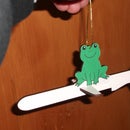Introduction: Mother-of-Pearl Inlaid Chisel
A year or so back I read an Instructable about carving metal.
I've finally got around to trying that, and the first thing to do was to make some graving tools to use.
The Instructabler tinkrmind had posted some nice wooden handles, so I decided to use that idea.
Since I had some scrap paua shell, I decided to decorate the handle by inlaying some nacre.
Step 1: Making the Handle
I had to pick a material for the handle from the dowels I had in the shop. Since I was making tools for delicate work, the thinner material would make the tool easier to control. I decided on the hardwood as it would be more robust, and it would use the shorter piece, leaving the longer softwood for future use.
There were two chunks for the two handles, sized so that the heel of my hand could apply pressure to the butt of the chisel while my fingers controlled the front of it.
The holes to fit the nails which I was using as the cutting tool had to be large enough to accommodate the head of the nail, and deep enough to hold the nail securely while leaving a decent length of shaft outside the handle.
Once the wood was drilled and checked, the same size of drill bit was used to drill a cross hole which met the axial hole.
Then I used increasingly finer grit paper to smooth the wood.
Step 2: Rough Shaping the Blade
The cutting bit needs to be quite hard steel. I used jeanluc38's idea of concrete nails.
There are better ways to accomplish this step. Lacking a bench grinder, I used an angle grinder.
One tool is to be a chisel tip, the other a round point. After rough shaping with the grinder, I gave a quick going on the stone by hand.
The sharpened tips were covered with a wine cork for safety. Also for another reason which will become apparent later.
Step 3: Making the Nacre Plug
The nacre plugs were cut from a crap chunk of paua shell. If you live in New Zealand, you can pick this off pretty much any beach. If you live elsewhere, you can buy online, use a local shell, or inlay pretty much anything you feel like (e.g. bone).
To start, pick a thicker piece of shell, and smooth flat. I used a belt sander, but this can be done by hand easily enough.
The shell itself can be cut easily enough with a coarse blade in a coping saw.
Get a couple of pieces which are larger than the shaft of the drill bit which you used to make the holes.
Use hot-melt glue to stick the flat side of one of the pieces to the butt of the drill shaft.
Then carefully use the belt sander to abrade the shell where it overhangs the edge of the drill shaft. The glue will hold the shell in compression, but has little tensile strength so the plug of mother-of-pearl can be easily removed from the drill bit after it is rounded to size. This task can also be done by hand sanding, but it will take a while and is awkward.
Once both shell plugs are cut, then pick any remaining glue off using a fingernail.
Step 4: Fitting the Blade and the Nacre
The glue is inserted through the cross hole.
Put a small dab at the bottom of the cross hole. Then insert the nail down the axial hole and push it into place. Then put the glue-gun into the cross hole and pump glue in until it comes out of the axial hole.
Take the nacre plug and insert it into the cross hole. Push down until it is just slightly proud of the wood of the handle.
Have a cup of tea (other beverages are available), while the glue cools and cures.
Mount the handle in a vice with the plug facing away from you, and use a strip of sandpaper to "towel-off". Once the bulk of the standout mother-of-pearl has been abraded away, switch to finer grades to leave the handle and the inlay smooth.
Then use a craft knife to cut off the surplus glue from the axial hole. Just press the blade through the glue until it contacts the shaft and then roll the tool. The resulting doughnut of glue can be picked off. Any threads of glue left by the glue-gun will be cleaned up automatically just by handling the tool during this stage.
Step 5: Finishing
After a final light sanding, a couple of coats of oil with wiping and then sanding down between coats.
The corks gave a useful way of hanging the tools while the oil dried.
I'm looking forward to using these, and I'll post the results if they're any good.













